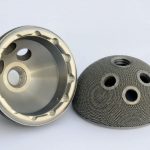Biomaterials have become a byword in recent years. Emerging technological advancement and research has led to an explosion in the availability and variety of biomaterials. Accompanying these new materials, there is a long history of biomaterials in the medical sciences, with evidence of their use as far back as 10,000 B.C.
The definition of a biomaterial is “any matter, surface, or construct that interacts with biological systems”. Biomaterials are defined primarily by their application of being integrated with the body, either for diagnostic or therapeutic applications. They can be artificially synthesized or derived from natural sources, and be made up of metallic, polymeric, ceramic, or a composite of these materials. Contrary to their name, they do not need to be biological in origin. Both biologically passive—like titanium or polyesters in heart valves—and bioactive—such as hydroxyapatite-coated bone implants—constitute biomaterials. Some combination products also make use of biomaterials — an example would be for an implantable drug-releasing material.
While the term “biomaterials” was coined in the 1960s, these materials have been used extensively in and on the body across the medical history of humankind. Traditional healers, seeking ways to assist with a patient’s wounds, have sought after objects in their surroundings. Ant mandible sutures are the oldest evidence of a biomaterial. Their use is documented up to 10,000 years ago during the Neolithic Period, both in South Africa and India. Simply enough, when two sides of a wound are held together and ants are held in place over the gap, they can bite and close parted skin back together. With a final twist to keep their jaws closed, this can effectively seal the wound in a similar way to modern sutures.
Modern technologies have taken biomaterials to the next level. Leveraging recent 3-D printing breakthroughs using biocompatible scaffolds, the latest achievements include that of a team at the Austrian Academy of Science, who were able to create a miniature human brain from embryonic and induced pluripotent stem cells. Through just under a month of growth, the brain developed into distinct regions, including a cerebral cortex and light-sensitive retinal tissue. Besides the brain, other organs are being 3-D printed to produce custom-fit, living body parts suited to individuals. Developed initially in the United States, the technique aims to replace scarred hearts, damaged jaws and even missing ears. Once printed into a desired shape, the scaffolds can then be seeded by stem cells created from patients’ own tissue by reverting functional cells back to a flexible “pluripotent” state, which then turn into specialized cells through mechanical and chemical prompts. The technology shows amazing possibilities if issues surrounding tissue thickness-related nutrient starvation and waste buildup can be solved. Solutions to this are being looked into, including printing tissue with micro-channels emulating the circulatory system.
While biomaterials are moving forward at an exponential rate, they are currently used across a wide swath of applications. To capture just how broad, a list of examples is provided below:
- Artificial ligaments and tendons
- Blood vessel prostheses
- Bone cement
- Bone wax
- Bone plates
- Breast implants
- Catheters
- Cochlear replacements
- Contact lenses
- Dental implants for tooth fixation
- Dialysis membranes
- Drug delivery mechanisms
- Heart valves
- Intraocular lenses (IOLs)
- Joint replacements
- Miniature Organs
- Nerve conduits
- Pins and screws for fracture stabilisation
- Skin repair devices
- Stents
- Surgical mesh
- Surgical sutures, clips, and staples for wound closure
- Vascular grafts
Design Considerations
An important consideration with biomaterials is their biocompatibility— this is defined as a material’s behavior in a variety of environments under chemical and physical parameters emulating biological interfacial conditions. When integrating a material, the body can react in a number of ways, including: Immune responses, cellular/tissue interaction, biofilm formation, and biological environment changes due to exposure to the material. Biocompatibility ties directly into the material’s application as a device, especially its local effects within a specific interface—what may be biocompatible in one application may not be in another. This regards where a device is used (e.g. skin, subdermal, venous), the time period of exposure to this area, and the frequency of exposure. Seeking precedents for similar applications of proven devices is a great way to start, as well as engaging with a QA/RA team, biocompatibility testing facility, and even contacting the FDA or other regulatory bodies. The widely used ISO 10993-1:2009 provides requirements for and testing of its biocompatibility. Note that the use of this standard depends on whether local regulatory guidelines refer to it. If this standard is part of your regulatory strategy, have a read of my colleague Julian Grove’s overview of how it can be applied to your medical device.
The challenges with introducing new or existing materials exist when it’s brought into unknown circumstances—that is, its integration within the biological system of a human body. Barriers to overcome relate to two fundamental concepts:
- Efficacy (Doing Good)
- Safety (Doing No-Harm)
Once fabricated into functional devices, biomaterials should do better than methods in accepted practice when it comes to efficacy and side effects. Efficacy is a material’s ability to function as intended. Within a medical context, the material should improve the situation that it is brought into and ensure that conditions improve due to its presence. This could be through the acceleration or enabling of healing that was not previously possible. Side effects, whether unpredictable or harmful, should be either minimized or eliminated from the interaction between a biological system and an introduced material. The most reliable way of harm reduction is relying on material degradation, leading to no residual traces of that material in the body, with the degradation products being either excreted or entered into natural metabolic pathways.
Looking ahead, many hurdles need to be resolved before new and novel biomaterials are used in a clinical setting on humans. Many of these hurdles are similar to those encountered during traditional medical device development. Focus should be placed on ensuring good results and no-harm through the use of biomaterials. These are exciting times, and it will be interesting to see how new treatments with biomaterials will further medicine in the coming years.








